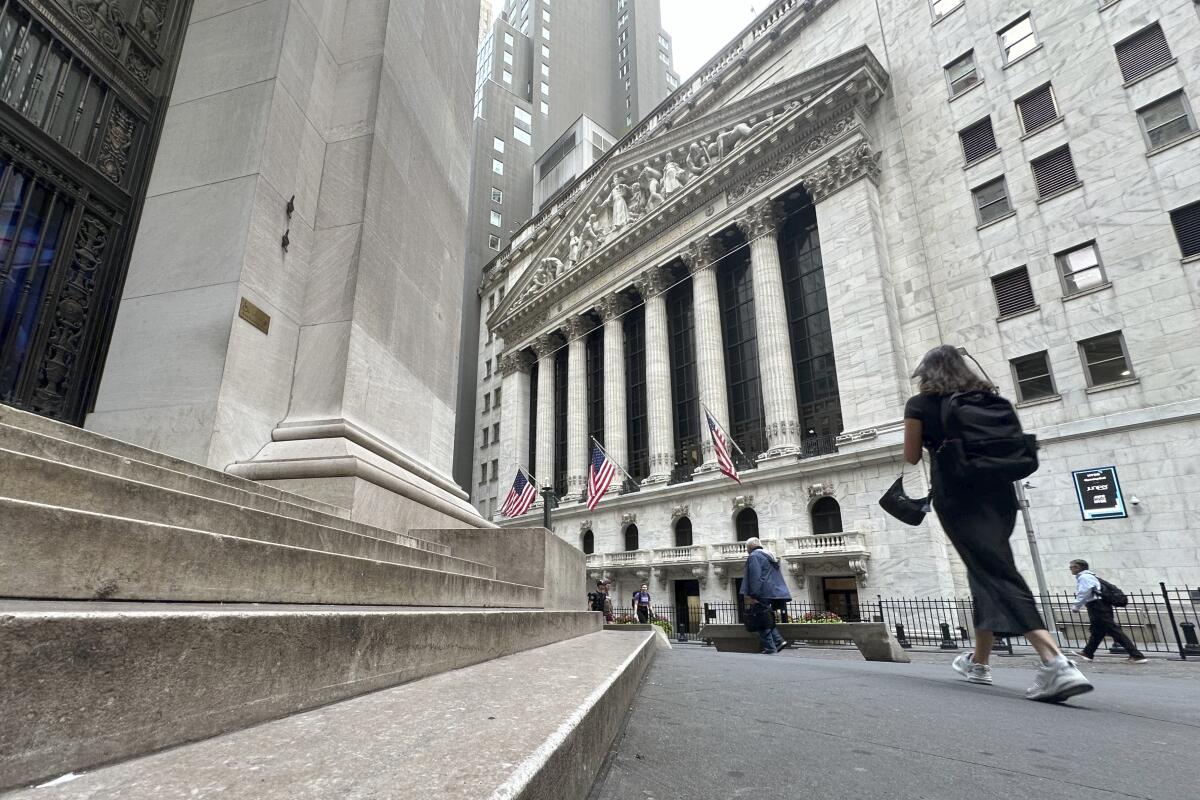Wall Street slips, breaking an 8-day winning streak for stocks

NEW YORK — U.S. stocks ticked lower Tuesday and snapped an eight-day winning streak, the longest of the year.
The Standard & Poor’s 500 slipped 0.2%, but it’s still just 1.2% below its all-time high set last month. It has roared back from its scary summer drop, when the index briefly dipped nearly 10% below its record.
The Dow Jones industrial average fell 0.2%, and the Nasdaq composite slipped 0.3%.
Chipmaker Nvidia was the heaviest weight on the market after falling 2.1%. It is one of Wall Street’s most influential stocks because a frenzy around artificial intelligence technology has made it one of the U.S. stock market’s most valuable companies at roughly $3 trillion.
Nvidia has recovered most of its summertime swoon, when its stock dropped more than 20% on worries that investors had gone overboard and taken its price too high, but it has remained shaky ahead of its earnings report scheduled for next week.
Boeing also weighed on the market, sinking 4.2%.
Federal safety officials are requiring inspections of cockpit seats on Boeing 787 Dreamliners. Boeing also has stopped test flights of a new version of its 777 jetliner after discovering a damaged structural part between the engine and the rest of the plane. The new model has not yet been approved by regulators.
Helping to limit the market’s losses was Palo Alto Networks. The cybersecurity company jumped 7.2% after becoming the latest big business to report stronger profit and revenue for the latest quarter than analysts expected. Companies in the S&P 500 are on track to report their best growth in earnings per share since the end of 2021, according to FactSet.
Lowe’s likewise topped analysts’ forecasts for profit in the spring, but its stock was more restrained. The home improvement retailer said it’s facing a challenging economic backdrop, “especially for the homeowner,” and cut its forecasts for revenue and profit this fiscal year. Its stock fell 1.2%.
High interest rates have been weighing on the economy after the Federal Reserve hiked them sharply to get inflation under control. On Tuesday, Treasury yields eased ahead of a speech on Friday by Federal Reserve Chair Jerome H. Powell, one that’s likely to be the week’s highlight for financial markets.
The economic symposium in Jackson Hole, Wyo., where Powell will be speaking has been the site of big policy announcements in the past. Expectations aren’t that high this time around, with nearly everyone already in agreement the Fed will begin cutting interest rates next month.
The biggest question is whether the economy needs the Federal Reserve merely to remove the brakes or whether it needs an extra boost requiring deeper and faster cuts.
A surprisingly weak report on hiring by U.S. employers last month raised worries the Fed has already kept interest rates too high for too long, but ensuing reports on inflation, retail sales and other data helped bolster optimism.
The yield on the 10-year Treasury fell to 3.81% from 3.87% late Monday.
On Wall Street, the company behind Hawaiian Airlines soared 11.3% after it said its proposed merger with the parent of Alaska Airlines had cleared a major regulatory hurdle. A review period by U.S. antitrust regulators for the deal has passed.
Alaska Air Group’s stock was basically flat.
All told, the S&P 500 slipped 11.13 points to 5,597.12. The Dow dipped 61.56 points to 40,834.97, and the Nasdaq fell 59.83 points to 17,816.94.
In stock markets abroad, Japan’s Nikkei 225 jumped 1.8%, clawing back all of its sharp loss from the day before. Tokyo has been home to some of the world’s most vicious moves for financial markets recently after the Bank of Japan raised interest rates there last month.
That hike triggered losses for markets around the world because it forced many hedge funds to abandon all at once a popular trade in which they had borrowed Japanese yen cheaply and invested it elsewhere. That included the worst day for Japan’s stock market since the Black Monday crash of 1987.
But an ensuing assurance from the Bank of Japan on interest rates has helped calm the market, along with the better-than-expected data on the U.S. economy.
The rebound for U.S. stocks after their scary couple of weeks is another reminder about the danger of trying to time the market. Anyone who sold their stock investments earlier this month when panic was high would have missed the recent eight-day winning streak for the S&P 500.
Historically, the market’s best and worst days tend to be bunched together, “often back-to-back” during recessions or down markets, according to Veronica Willis, global investment strategist at Wells Fargo Investment Institute.
Choe writes for the Associated Press.
More to Read
Inside the business of entertainment
The Wide Shot brings you news, analysis and insights on everything from streaming wars to production — and what it all means for the future.
You may occasionally receive promotional content from the Los Angeles Times.










